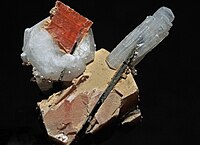
Photo from wikipedia
The aim of this study was to test the performance of a novel method for acid rock drainage (ARD) control through the formation of Al(OH)3-doped passivating surface layers on pyrite.… Click to show full abstract
The aim of this study was to test the performance of a novel method for acid rock drainage (ARD) control through the formation of Al(OH)3-doped passivating surface layers on pyrite. At pH 2.0 and 4.0, there was no obvious inhibition of the pyrite oxidation rate on addition of 20 mg L-1 Al3+ (added as AlCl3·6H2O). In comparison, the pyrite oxidation rate at circumneutral pH (7.4 ± 0.4) decreased with increasing added Al3+ with ≈98% reduction in long-term (282 days) dissolution rates in the presence of 20 mg L-1 Al3+. Al3+ was added to the solution and allowed to equilibrate prior to pyrite addition (2 g L-1). Consequently almost all Al3+ (>99.9%) was initially present as aluminum hydroxide precipitates at pH 7.4. X-ray photoelectron spectroscopy analysis showed a significant concentration of Al3+ (20.3 at. %) on the pyrite surface reacted at pH 7.4 with 20 mg L-1 added Al3+, but no Al3+ on pyrite surfaces reacted at pH 2.0 and 4.0 with added Al3+. Transmission electron microscopy and synchrotron X-ray absorption near edge spectroscopy analyses indicated that compact surface layers containing both goethite and amorphous or nanocrystalline Al(OH)3 formed in the presence of 20 mg L-1 Al3+ at circumneutral pH, in contrast to the porous goethite surface layers formed on pyrite dissolved in the absence of Al3+ under otherwise identical conditions. This work demonstrates the potential for novel Al-based pyrite passivation of relevance to the mining industry where suitable Al-rich waste materials are available for ARD control interventions.
Journal Title: Environmental science & technology
Year Published: 2018
Link to full text (if available)
Share on Social Media: Sign Up to like & get
recommendations!